|
Joseph
Drouhin
Visiting
Burgundy, part 1
Website:
www.drouhin.com
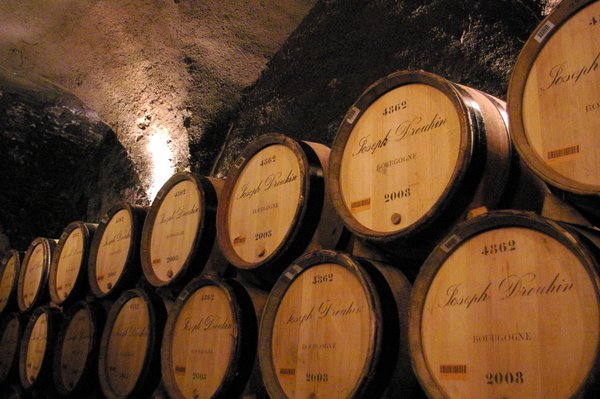
In
1880, at the age of 22, Jospeh Drouhin—originally from Chablis—decided
to move to Beaune and begin a wine business. He purchased the house
in the centre of the town that is now the headquarters of Drouhin,
and gradually grew his company. His
son Maurice took over in 1917 and grew the business largely through
the acquisition of vineyards. His first purchase was the Clos des
Mouches.
The
next generation to take the helm was Maurice’s son, Robert, in
1957. Robert is still the chairman of the company, but retired at
the executive level in 2003. Drouhin is now in the hands of four
siblings of the fourth generation. Philippe (the eldest) is the
vineyard manager, Veronique is the oenologist, Laurent is in charge
of the US market, and Frederic (the youngest) is president.
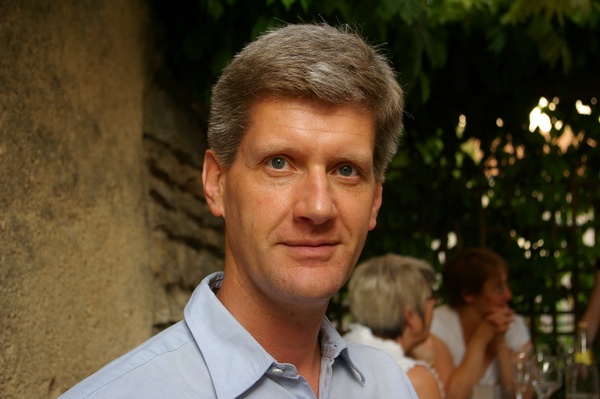
On
my visit, I met with Philippe Drouhin (above) and
Jean-François Curie (Vice President Sales and Marketing).
Drouhin
is both a large estate and a small merchant house. They own two
Burgundy domains: one in Chablis (38 hectares) and one in Côte d’Or
(35 hectares, largely in the Côtes de Nuit and Côte Chalonnaise,
90% of which is Premier and Grand Cru vineyards). In addition, they
have a 73 hectare estate in Oregon (Domaine Drouhin Oregon). In
terms of volume, two-thirds of the business is the negociant wine,
but in terms of value, two-thirds is the estate wine.
The
main winery, out of town, was built in the 1980s. In vintage 2007,
the winery was reequipped with vertical presses for reds and and
large open horizontal presses for whites, rather than the more
modern pneumatic presses. This is because of worries about the
premature oxidation problem that has been affecting many white
Burgundies. One of the contributory factors cited by some has been
that the pneumatic presses protect the juice too much from oxygen,
resulting in more fragile wines. The older presses allowed some
juice oxidation, which removes phenolic compounds before
fermentation, and counterintuitively gives the wines a longer life.
Also in response to the premature oxidation problem, Drouhin stopped
using silicon-coated corks from 2003, reverting to the more
traditional paraffin coating.
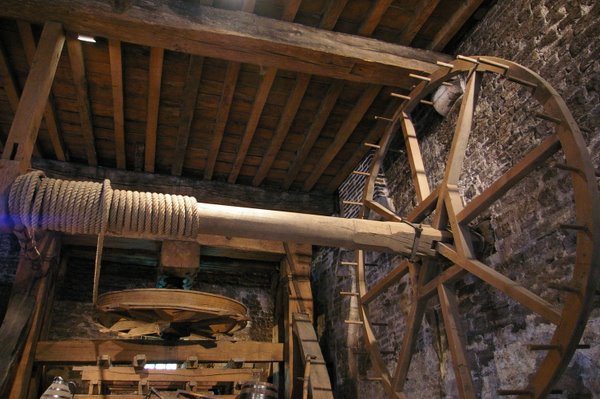
In
the Beaune house they still have a historical press dating back to
1563, which is still functioning. It’s not used routinely, but is
put into action for special occasions.
As
with most Burgundian producers, almost all Drouhin’s wines go
through barrels. Drouhin buy their own trees and season the wood
themselves for three years outside. The barrels are then made for
them. They use no more than 20% new oak for any of their wines, and
each of their barrels has a special barcode, to make tracking the
wines through their élévage more straighforward. Up to 1000 of the
6000 they use at any one time are stored in the Beaune cellars. The
cellars are remarkable, stretching under the city. The oldest dates
back to the 13th century. These were bought step by step, with the
most recent acquisition actually being the oldest cellar of all,
purchased in the 1950s.
Philippe
says that the 2007 vintage experienced some difficulties. After very
early budburst, it wasn’t easy during the cool summer, with some
botrytis appearing in August. It was saved by a nice September: the
key was to wait and not be in a hurry because botrytis had started.
The wines needed some work to give them roundness that they didn’t
have coming out of fermentation. Even though the reputation of the
2007 vintage is not high, the whites deserve a good reputation. In
2007 the terroirs show their presence a bit more than in 2005 and
2006.
2008
was another vintage made by sunny September weather. ‘What counts
is really what happens 4 weeks prior to harvest’, says Philippe.
2008 was later than 2007, and there was a bad August which triggered
some botrytis. There were, apparently, lots of depressed growers at
the end of August. ‘But September saved everyone’. It stopped
the botrytis, and the cool-ish sunny conditions helped maintain a
very good level of acidity. ‘If you did everything right, 2008 has
made some very good wines’, says Philippe. There was almost no
chaptalization this vintage.
Drouhin
are famous for their wines from the Clos des Mouches vineyards,
which is south of Beaune, bordering on Pommard. Mouches
translates as honey bee. The vineyard was acquired by Maurice
Drouhin, and at the time this area made only red wines. However,
some Chardonnay was grown, and was used to lighten the reds.
Typically, these Chardonnay vines would be interplanted among the
Pinot Noir. However, Maurice decided to put his Chardonnay in a
separate block. One year, when the reds failed he was forced to
vinify the Chardonnay separately, and it was a great success. Now
Drouhin have half Pinot and half Chardonnay in this vineyard. The
vines have an average age of 40 years and are naturally low
yielding. They are also managed using organic and biodynamic
practices.
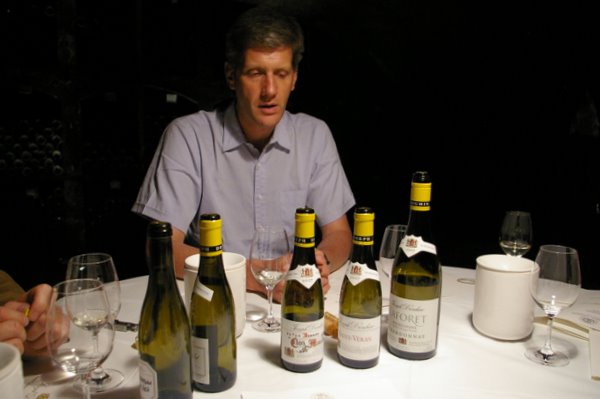
Philippe,
born in 1961, is in charge of the vineyards at Drouhin. In 1986,
aged 25, he decided to join the family company. ‘My father told me
it all starts in the vineyard and that I didn’t know anything
about vineyards, so I needed to go back to school.’ So Philippe
went to study Viticulture and Oenology at Dijon and Beaune.
During
his studies, he was struck by the warnings from teachers about the
use of fungicides. He was told not to use them more than twice a
year because of the risk of resistance developing, and of the
existence of 60 day exclusion periods because of residues that would
otherwise prevent the yeasts functioning normally. There were also
issues such as the use of miticide sprays in the 1960s that killed
some mites that were natural predators of the mites that are a
problem today. ‘The negative impact of new chemicals made me
wonder whether there was a safer way,’ Philippe recalls. He
remembers that when he asked his teachers about the likely effects
on the soil of a cocktail of chemicals sprayed on vines, no one had
any idea.
‘So
I decided to look for an alternative way,’ he states. ‘Looking
back, I found that people had used just sulfur and copper sulfate
for a long time. I looked at organic and biodynamic vineyards at
harvest, and thought that I could do this.’ But Philippe realized
that he couldn’t suddenly rock up and tell everyone in the company
to change the way they worked, because he was only in his mid-20s.
His father, who had been overseeing vineyard operations since 1957
agreed to allow Philippe to begin changing things, with the proviso
that he go slowly at first. ‘So I began with a few vineyards and
progressively converted them to organics’, he recalls. ‘Everything
in the Côte d’Or was converted by 1997, and Chablis was converted
two or three years later.’
Philippe
soon made the acquaintance of other growers in the Côtes de Beaune
interested in biodynamics, and together they formed a study group,
inviting a teacher to come and instruct them—agriculture expert
Pierre Masson of Biodynamie Services. He started with biodynamie in
the Côte d’Or, and when he felt confident, extended the approach
to Chablis. Now everything in the Drouhin estate is organic and
biodynamic. ‘I did this for technical reasons, because I think it
is better for the soils and the wine’, says Philippe. ‘It’s
also much safer. We know copper [one of the permitted fungicides in
biodynamics] is not good for the soils, but at least we know what it
is.’ He emphasizes that the switch was not made for commercial
reasons. ‘At the time I started, it was counterproductive to say
that you were organic. Recently, it has been commercially useful for
people to follow the consumer trend for green things, so many
estates are starting to pretend that they are organic, or “part
organic”. I didn’t want to be in that category, so in August
2006 I asked for certification for all the estates, with Ecocert.’
Drouhin
belongs to an organization called G.E.S.T. (groupement
d’étude et suivi des terroirs,
which translates as a ‘group for the study and following of
terroirs’). There are over 100 members, including some of the most
famous names in the region. ‘We were not happy with how INRA
viewed how the soil functions, so we built our own knowledge base,’
says Philippe. A key figure in this organization is Yves Hérody, a
pedogeologist from the
Jura who consults worldwide. ‘He has a vision of how soils
function. We formed this group to learn about soils and also to form
an entity who would make compost for us. Part of this company also
makes the biodynamic preparations.’
In
Burgundy, very few vineyards are under the sole control of a single
producer. In the most famous vineyards, it is common for some
growers to have just a few rows of vines. So is it possible to do
biodynamics on just a fraction of a vineyard? ‘The neighbours in
some vineyards have some influence on us,’ admits Philippe. ‘It
would not be honest to say I know how much influence they have. As
soon as we have a fair number of rows then we have enough effect
that it is worth doing.’
One
thing Philippe is keen to investigate is how much biodynamics can
help reduce interventions in the vineyard. ‘It may be that we can
enhance the resistance of the vines,’ he speculates. ‘Last year
we had responsibility for a new vineyard in Chablis. We already had
a parcel in Vaillons 100 m away that was run biodynamically. This
new vineyard was previously conventionally farmed, and in it we had
a burst of downy mildew even though we used the same regime in both
vineyards. It was obvious that there was less self-defence in that
vineyard.’
Currently,
Drouhin are experimenting in the winter with deep ploughing versus
cover-cropping. ‘We think deep ploughing may not be the best
answer, even though it is traditional’, says Philippe. He says
that it is difficult to fine-tune the cover cropping during the
growing season, and that it’s necessary to manage each vineyard
depending on its characteristics.
One
interesting anecdote concerned the practice of burying cows’ horns
in the vineyards with biodynamic preparation BD500, which contains
dung from a lactating cow. Cows’ horns differ from bulls horns in
that they have a series of rings (calving rings) in them. Some
students from Dijon made the mistake of burying some bulls’ horns
as well as cows’ horns, and when they dug them up the contents of
the bulls’ horns were stinky, but the cows’ horns were lovely,
like humus.
On
average, Philippe uses 3 kg of copper per hectare each year. The law
allows 6 kg/hectare per year, based on a five-year average.
According to Claude Bourgignon, a soil scientist, the soils can
absorb 3 kg/ha per year. ‘This used to be sprayed in a single go
in the 1950s,’ comments Philippe.
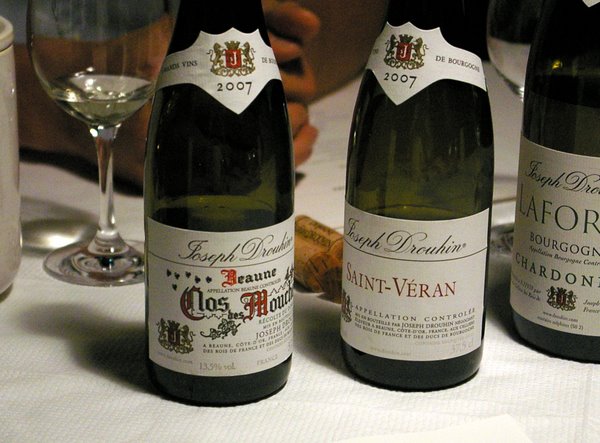
The
wines
2008
Vat samples: these will probably be bottled by October or November.
Drouhin
Meursault 2008
Big, rich, toasty nose
with bold fruit and nice oak. The palate is fresh and intense with
lovely acidity and depth of fruit. Real intensity. This has done 80%
of malolactic.
Drouhin
Chassagne Montrachet 2008
95% malolactic completed.
Wonderfully rich, focused and intense with dense, lively fruit.
Impressive.
Drouhin
Puligny Montrachet 2008
Completed malolactic.
Very fresh, minerally and bright with lovely focus and freshness.
Drouhin
Volnay 2008
Still doing malolactic.
Fresh, focused and intense with a bit of spritziness still. Nice
depth of fruit.
Drouhin
Beaune 1er Cru Greves 2008
Firm, spicy and
chocolatey. Reductive and tight with good structure and acid.
Drouhin
Chambolle Musigny 1er Cru 2008
Reductive nose. Very
attractive structure and elegant bright fruit with some wood showing
at present. Bright and focused.
Chablis:
new branding for 2008 is ‘Drouhin-Vaudon’
Drouhin
Vaudon Chablis ‘Propriétés’ 2008
Bright, taut lemony nose
with some grapefruit notes. Very fresh, almost like a Sauvignon
Blanc. Herby, fresh and intense with lively aromatics. 88–91/100
Drouhin
Vaudon Chablis Grand Cru Vaudesir 2008
Vinified in barrels, but
no new oak. Creamy and intense. Very rich and mineralic with lovely
breadth and some almost spicy intensity. Lovely wine. 91–93/100
2007
Côte d’Or wines, plus some older vintages
Drouhin
Laforêt Bourgogne Blanc 2007
Fresh, focused, nutty
nose is quite broad with some mineral notes. Lovely expressive
bright nutty fruit here. An attractive fruit-driven wine. 88/100
Drouhin
Saint Veran 2007
Rounded, fruity and
subtly mealy on the nose with nice breadth. Nice volume on the
palate. Nutty with some citrusy notes and a bit of minerality.
88/100
Drouhin
Beaune Clos des Mouches Blanc 1er Cru 2007
Wonderfully sophisticated
tight, minerally, toasty nose. Really refined, complex and minerally.
The palate is taut, bready and toasty with lovely fruit intensity
and great complexity. 94/100
Drouhin
Chassagne Montrachet 1er Cru Morgeot Marquis de Laguiche 2007
Taut, herby, toasty nose
is quite tight knit with nice fruit. The palate is concentrated and
tight with firm acidity and some herbiness. Bold, firm and quite
mineralic, with lots of intensity. 92/100
Drouhin
Montrachet Grand Cru 2007
Amazingly intense, taut
herby nose with bold, multilayered fruit. There are notes of
minerals, herbs, nuts and figs. The palate is minerally, tight and
long with a lovely savoury dimension as well as rich, bold fruit.
Fantastic intensity and well integrated spicy oak. 95/100
Drouhin
Chorey Les Beaune 2007
Pale colour. Lovely fresh
sappy cherry and herb fruit nose. Attractive and fruity. The palate
is bright, fresh and sappy with lovely focus and good acidity.
87/100
Drouhin
Beaune Clos des Mouches 1er Cru Rouge 2007
Pale cherry colour.
Aromatic cherry, herb, spice and mineral nose. The palate is bright
and expressive with firm cherry and berry fruit, nice acidity and
minerality, and a taut, focused personality. 89/100
Drouhin
Chambolle Musigny 1er Cru 2007
Pale colour. Lovely open
sappy nose with gently herby cherry fruit. Very fresh. Palate is
juicy and bright with nice minerally complexity and elegant fruit.
Good acidity. 91/100
Drouhin
Griotte Chambertin Grand Cru 2007
Enticing, aromatic, sappy
herby nose with a hint of ‘nice’ greenness, as well as some red
cherry fruit. The palate is fresh and sappy with focused fresh
cherry and berry fruit. 91/100
Drouhin
Clos de Vougeot Grand Cru 2007
Enticing nose with
focused cherry fruit that has some depth. There’s also some fruity
richness and a bit of spiciness. The palate is precise and focused
with bright cherry fruit and some spicy structure. Firm finish.
Lovely intensity here. 93/100
Drouhin
Bonnes Mares Grand Cru 2007
Beautifully delicate,
elegant, focused nose with pure red berry fruit and refined, spicy
notes. The palate is taut and elegant with spicy complexity and firm
but fine-grained tannins. Subtle hints of meat, too. Focused and
spicy with a firm finish. A lovely mineral wine. 94/100
Drouhin
Chambertin Clos de Beze Grand Cru 2007
Quite a big, structured
wine that’s dense, spicy and a bit chocolatey on the palate with
firm tannins and good acidity. Very fresh bright cherry and berry
fruit here. Quite pure with good structure. 92/100
Drouhin Montrachet Marquis de Laguiche 2003
Rich, intense and taut with lovely bold, ripe, spicy fruit. Real
power here. Bold, figgy and spicy with vanilla and herb notes, and
also good acidity and freshness. A rich style with great intensity
and focus. 93/100
Drouhin
Chambolle Musigny 1er Cru 2000
Beautifully perfumed and
elegant with lovely dark cherry fruit, some berry notes, plus lovely
earthy, spicy, undergrowth complexity.
Lovely purity of fruit here, and attractive herb and spice notes.
Drinking perfectly now. 94/100
Drouhin
Beaune Clos des Mouches 1990
Very dense but
beautifully sweet and ripe with notes of undergrowth and spice, as
well as elegance. Herb and tar notes too. Dense structure. A rich,
bold wine with lovely richness and intensity. 95/100
BURGUNDY
SERIES
 Joseph
Drouhin Joseph
Drouhin
 J-P
Fichet J-P
Fichet
 Pierre
Morey/Morey Blanc Pierre
Morey/Morey Blanc
 Louis
Latour Louis
Latour
 Domaine
Dujac Domaine
Dujac
 Sylvain
Cathiard Sylvain
Cathiard
 Clos
du Tart Clos
du Tart
Wines
tasted 06/09
Find these wines with wine-searcher.com
Back
to top
|

